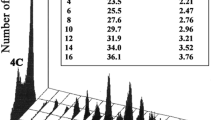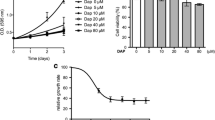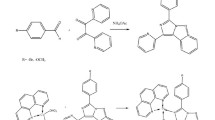Summary
The mechanism of action of a new mitomycin C (MMC) derivative, KT6149, was studied in human leukemia HL-60 cells and in isolated phage and plasmid DNA, and its effects were compared with those of MMC. Cell growth was markedly inhibited by KT6149, with an IC50 of 2 × 10−9 M, that for MMC being 2 × 10−8 M. DNA synthesis of HL-60 cells as determined by incorporation of [3H]-thymidine was also inhibited by KT6149, with an IC50 of 2 × 10−7 M as compared with 2 × 10−6 M for MMC. RNA and protein synthesis were less markedly inhibited at low concentrations. Alkaline sucrose density-gradient centrifugation revealed a significant decrease in sedimentation velocity for cellular DNA of the cells after 1 h treatment with KT6149 at concentrations higher than 10−7 M. In contrast, no such change was observed for DNA of cells treated with MMC, even at a concentration of 10−5 M. In a cell-free system, analysis by agarose gel electrophoresis patterns showed that the drug induced a decrease in the amount of covalently closed circular DNA of phage PM2 and an increase in that of open circular DNA in the presence of dithiothreitol (DTT), whereas MMC did not cause any change in DNA subfraction amounts. Furthermore, the electrophoretic mobility of linearized pBR322 DNA in alkaline agarose gel was significantly decreased by KT6149 in the presence of DTT and FeSO4, no such change being observed in the case of MMC. The results clearly indicate that the inhibitory effects of KT6149 on the growth and DNA synthesis of HL-60 cells are more potent than those of MMC and that KT6149-induced DNA damage is due to single-strand scission and to cross-linking of DNA, suggesting a mode of activation different from that of MMC.
Similar content being viewed by others
Abbreviations
- KT6149:
-
7-N-[2-[[2-(γ-l-glutamylamino)ethyl]dithio]ethyl]mitomycin C
- MMC:
-
mitomycin C
- IC50 :
-
concentration of drug that inhibits cell growth or incorporation of radiolabeled precursors by 50%
- DTT:
-
dithiothreitol
References
Adij C, Borst P (1972) The gel electrophoresis of DNA. Biochim Biophys Acta 269: 192–200
Akinaga S, Morimoto M (1988) Studies of a novel mitomycin derivative, KT6149: III. Cross-link formation of cellular DNA. Proceedings, 47th Annual Meeting of the Japanese Cancer Association (September 20–21, Tokyo), p 590
Ashizawa T, Akinaga S, Azuma M, Miyoshi K, Kono K, Kasai S, Morimoto M (1988) Studies of a novel mitomycin C derivative, KT6149: I. Antitumor activity. Proceedings, 47th Annual Meeting of the Japanese Cancer Association (September 20–21, Tokyo), p 589
Cook PR, Brazell IA (1976) Detection and repair of single strand breaks in nuclear DNA. Nature 263: 679–682
Glaubiger D, Ramu A (1982) Antitumor antibiotics. In: Chabner B (ed) Pharmacologic principles of cancer treatment. W. B. Saunders, Philadelphia, pp 402–415
Hata T, Sano Y, Sugawara R, Matsumae A, Kanamori K, Shima T, Hoshi T (1956) Mitomycin, a new antibiotic fromStreptomyces (part I). J Antibiot 9: 141–146
Lown JW, Begleiter A, Johnson D, Morgan AR (1975) Studies related to antitumor antibiotics: V. Reactions of mitomycin C with DNA examined by ethidium fluorescence assay. Can J Biochem 54: 110–119
Lown JW, Sim SK, Majumdar KC, Chang RY (1977) Strand scission of DNA by bound Ariamycin and daunorubicin in the presence of reducing agents. Biochem Biophys Res Commun 76: 705–710
Makino F, Okada S (1974) Comparative studies of the effects of carcinogenic and antitumor agents on the DNA replication of cultured mammalian cells. Mutat Res 23: 387–394
Pratt W, Ruddon R (1979) The anticancer drugs. Oxford University Press, Oxford, pp 174–177
Strong JE, Crooker ST (1978) DNA breakage by tallysomycin. Cancer Res 38: 3322–3326
Suzuki H, Miura K, Tanaka N (1979) DNA-cleaving potential of macromycin and auromomycin: a comparative study. Biochem Biophys Res Commun 89: 1281–1286
Tomasz M, Chowdary D, Lipman R, Shimotakahara S, Veiro D, Walker V, Verdine GL (1986) Reaction of DNA with chemically or enzymatically activated mitomycin C: isolation and structure of the major covalent adduct. Proc Natl Acad Sci USA 83: 6702–6706
Author information
Authors and Affiliations
Rights and permissions
About this article
Cite this article
Ishioka, C., Kanamaru, R., Konishi, Y. et al. Comparative studies on the action of 7-N-[2-[[2-(γ-l-glutamylamino)ethyl]dithio]ethyl]mitomycin C and of mitomycin C on cultured HL-60 cells and isolated phage and plasmid DNA. Cancer Chemother Pharmacol 26, 117–121 (1990). https://doi.org/10.1007/BF02897256
Received:
Accepted:
Issue Date:
DOI: https://doi.org/10.1007/BF02897256




